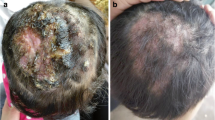Abstract
A 13-year old black girl presented with an unusual scalp lesion felt to be compatible with mycotic granuloma. She had undergone surgery two years earlier for removal of three similar scalp lesions. Material excised during surgical removal of the cyst-like lesion again revealed histopathology compatible with mycotic granuloma. Surgical material cultured out pure growth of a fungus identified as Microsporum canis Bodin. Subsequent histopathological study of the infected tissue resulted in a diagnosis of dermatophytic ‘mycetoma’. The disease will be reviewed and discussed as regards its nomenclature, histopathology and salient clinical features.
Similar content being viewed by others
References
Ajello, L., Kaplan, W. & Chandler, F. W., 1980. Dermatophyte mycetomas: fact or fiction? pp. 135–140. In: Proc. Fifth Intl. Conf. Mycoses. Pub. No. 396, Pan American Health Organization, Washington, D.C.
Araviysky, A. N., Araviysky, R. A. & Eschov, G. A., 1975. Deep generalized trichophytosis. Mycopathologia 56: 47–65.
Araviysky, A. N., 1977. Endotriche als Erreger einer tiefen Mykose. Mykosen 20: 449–462.
Artom, M., 1933. Imponenti formazioni tumorali profonde da Trichophyton in tricofizia universale. Giorn. Italiano Derm. Sifilo 74: 563–582.
Azulay, R. D., 1957. Contribution to the problem of dermatomycosis classification. A new clinical type of trichophytic granuloma. pp. 1184–1196. In: Proc. Eleventh Intl. Cong. Dermatol. Acta. Dermatol. Venereol.
Baker, R. D., 1971. Human infection with fungi, actinomycetes, and algae. Springer-Verlag, New York.
Baylet, R., Camain, R., Juminer, B. et al., 1973. Microsporum ferrugineum OTA, 1921, agent de mycetomes du cuir chevelu en Afrique noire. Pathologie-Biologie 21: 5–12.
Beirana, L. & Novales, J., 1959. Tinea universal y granulomatosa por Trichophyton tonsurans. Derm Rev. Mex. 3: 4–16.
Blanche, R., Destombes, R. & Nazimoff, O., 1961. Novelles mycoses souscutanees au Sud-Cameroun. Bull. Soc. Path. Exotique 54: 56–63.
Blank, H. & Smith, J. G., 1960. Widespread Trichophyton rubrum granulomas treated with griseofulvin. Arch Dermatol. 81: 779–789.
Bourdin, M., Destombes, P., Parodi, A. L. et al., 1975. Première observation d'un mycetoma a Microsporum canis chez un chat. Rev. Med. Vet. 151: 475–480.
Burgoon, C. F., Blank, F., Johnson, W. C. et al., 1974. Mycetoma formation in Trichophyton rubrum infection. Br. J. Dermatol. 90: 155–162.
Camain, R., Baylet, R., Nouhouayi, Y. et al., 1971. Note sur les mycetomes de la nuque et du cuir chevelu de L'Africain. Bull. Soc. Pathol. Exotique 64: 447–454.
Cremer, G., 1953. A special granulomatous form of mycosis on the lower legs caused by Trichophyton rubrum Castellani. Dermatologica 107: 28–37.
Destombes, P., 1964. Structure histologique des mycetomes. Ann. Soc. Belge. Med. Trop. 44: 897–908.
English, M. P. & Tucker, W. D. L., 1978. Atypical strains of Microsporum canis. Mycopathologia 63: 113–120.
English, M. P., 1978. The dysogonic strain of Microsporum canis. Mycopathologia 64: 73–81.
English, M. P., Gentles, J. C. & Ball, E. H., 1979. Experimental infection of guinea-pigs with atypical and dysgonic strains of Microsporum canis. Mycopathologia 67: 179–181.
Feuerman, E. J. & Alteras, I., 1980. Some unusual cutaneous manifestations of Trichophyton rubrum in Israel. Mykosen 23: 619–626.
Frey, D. & Lewis, M. B., 1976. Mycetoma of the scalp in an aboriginal child. Aust. J. Dermatol. 17: 7–9.
Fukushiro, R., 1960. Deep mycoses in Japan, J. Juzen Med. Soc. 65: 341–356.
Gomez Orbaneja, J. et al., 1967. Favus generalizado. Forma granulomatosa. Acta Dermo-Sif 58: 339–346.
Grimmer, H., 1974. Mykotisches Granulom durch Trichophyton terrestre. Mykosen 17: 333–338.
Hadida, E. & Schousboe, A., 1959. Aspect de la maladie dermatophytique. Algerie Médicale. Avril, pp. 303–336.
Honig, P. J. & Smith, L. R., 1979. Tinea capitis masquerading as atopic or seborrheic dermatitis. J. Pediatrics 94: 604–605.
Kaplan, W., 1978. Protothecosis and infections caused by morphologically similar green algae. pp. 218–232. In: Proc. Fourth Intl. Conf. Mycoses. Publ. No. 356. Pan American Health Organization, Washington, D.C.
Kwon-Chung, K. J., Bonder, R. H., Fethier, A. & Blank, F., 1977. Enigmatic relationship of two Microsporum species. Sabouraudia 15: 325–332.
Kwon-Chung, K. J. & West, B. C. Mycetoma caused by dermatophytes: a review. Proc. First Intl. Symp. Mycetomas, Venezuela (in press).
Liber, A. F. & Hahn Choi, H.-S., 1973. Splendore-Hoeppli phenomenon about silk sutures in tissue. Arch. Pathol. 95: 217–220.
Majocchi, D., 1883. Sopra una nuova tricofizia (granuloma tricofitico). Studi clinici e micologici. Boll. R. Accad. Med. Roma. 9: 220–223.
Meinhoff, W. et al., 1976. Multiple subkutane Trichophyton rubrum Abszesse. Pathomorphose einer generalisierten superfiziellen Tinea bei gestörter Injektabsehr. Hautartz 27: 318–327.
Midgley, G., 1981. A glabrous Microsporum canis in greater London. Sabouraudia 19: 71–77.
Mikhail, G. R., 1974. Trichophyton rubrum granuloma. pp. 742–743. In: Dermatology — Proc. XIV Intl. Cong.
Padilha-Goncalves, A., 1980. Granulomatous dermatophytia. pp. 141–147. In: Proc. Fifth Intl. Conf. Mycoses. Publ. No. 396, Pan American Health Organization, Washington, D.C.
Ramose e Silva, J., 1949. Sobre e etiologia de foliculite e perfoliculite abscedens et suffodiens. An. Bras. Dermatol. Syph. 24: 188.
Rippon, J. W., 1974. Medical Mycology. The pathogenic fungi and the pathogenic Actinomycetes. W. B. Saunders, Philadelphia, Pennsylvania.
Segal, E., Padhye, A. A. & Ajello, L., 1976. Susceptibility of Prototheca species to antifungal agents. Antimicrob. Ag. Chemother. 10: 75–79.
Shetsiruli, L. T., 1974. Mycotic infections of skin caused by Trichophyton rubrum simulating various dermatoses and other fungus diseases. In: Dermatology — Proc. XIV Intl. Cong. p. 748.
Vanbreuseghem, R. & Vandeputte, M., 1959. Mycetome de la nuque chez Noir du Congo belge. Ann. Soc. Belge. Med. Trop. 39: 227–238.
West, B. C. & Kwon-Chung, K. J., 1980. Mycetoma caused by Microsporum audouinii. Am. J. Clin. Pathol. 73: 447–454.
Wilson, J. W., 1952. Trichophytic granuloma (Tinea profunda) due to Trichophyton rubrum. Arch. Dermatol. 65: 375–376.
Wilson, J. W., Plunket, O. A. et al., 1954. Nodular granulomatous perifolliculitis of the legs caused by Trichophyton rubrum. Arch. Dermatol. Syphilol. 69: 258–277.
Author information
Authors and Affiliations
Rights and permissions
About this article
Cite this article
Rinaldi, M.G., Lamazor, E.A., Roeser, E.H. et al. Mycetoma or pseudomycetoma?. Mycopathologia 81, 41–48 (1983). https://doi.org/10.1007/BF00443908
Issue Date:
DOI: https://doi.org/10.1007/BF00443908




